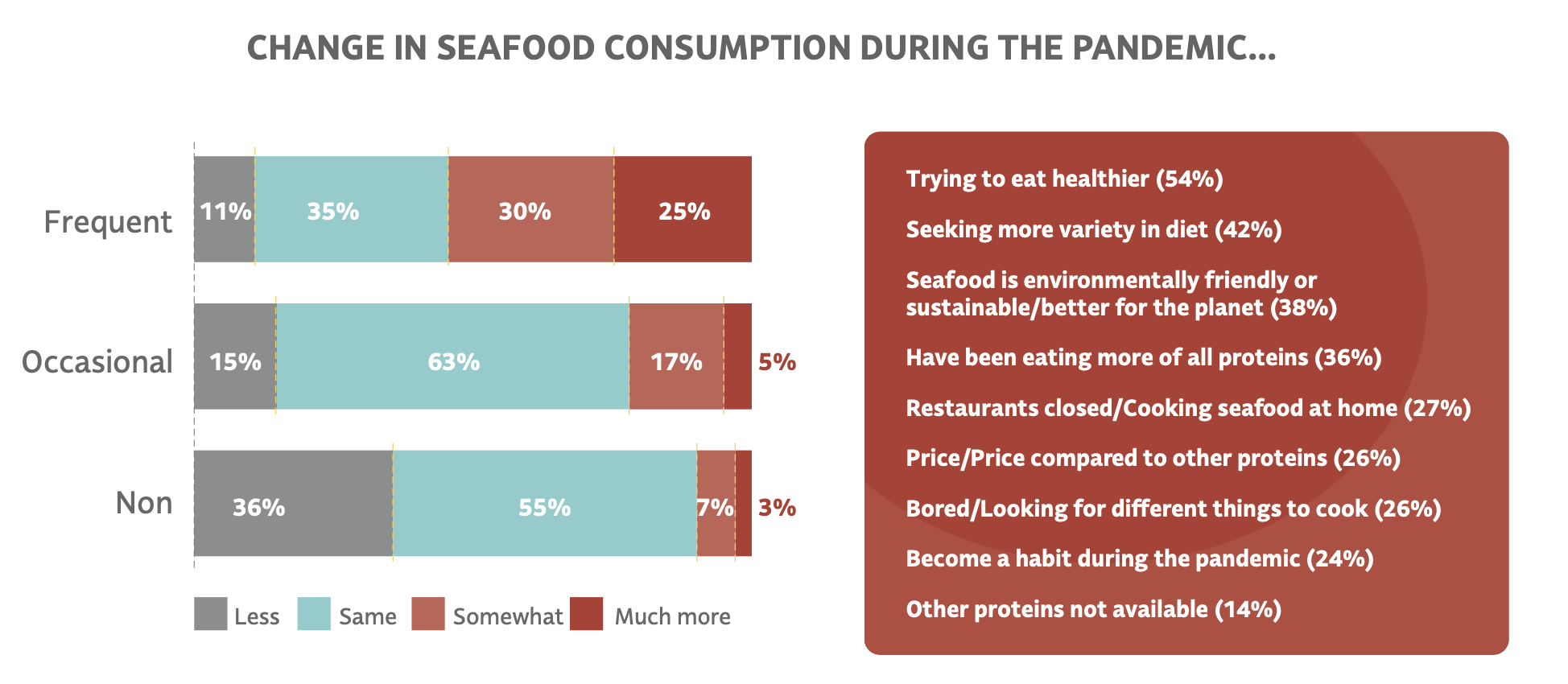Seafood department sales at retailed totaled $16.9 billion in 2021, an increase of 0.9% over 2020’s pandemic-spurred sales, according to the newly released Power of Seafood report from FMI-The Food Industry Association. Seafood sales had grown 28.4% in 2020.
“In 2020, the seafood department witnessed a major jump in sales, and in 2021, we see that trend holding steady and even increase slightly,” noted Rick Stein, vice president of fresh foods for FMI. “This is in part due to more shoppers discovering seafood and learning how to cook and prepare it at home. The analysis identifies an opportunity for grocers to continue to support shoppers’ seafood desires with information about cooking, preparation and sustainability.”
Several consumer trends have led to higher seafood sales, says the report, including growing seafood consumption among frequent seafood consumers, more shoppers cooking and preparing seafood at home and more shoppers choosing seafood for sustainability reasons.
The Power of Seafood finds 59% of shoppers are frequent (two or more times a week) or occasional (once a month to one time a week) seafood consumers, and frequent seafood consumers are eating more seafood at mealtimes than in previous years (55%). Forty percent of seafood consumers say they are buying new or different types of seafood and value-added seafood options, like heat-and-eat or grab-and-go seafood meals (44% buying more), sushi (43%) and fresh seafood that is marinated or seasoned (41%).

Half of seafood consumers (49%) are cooking more meals with seafood since the pandemic, and 73% of seafood consumers who are cooking more are more comfortable cooking seafood. Further, most seafood consumers want to still know more about how to cook, prepare or flavor seafood (80%) and new and different ways to cook seafood (83%).
“This heightened confidence means seafood shoppers are looking to gain new exposure to seafood products,” said Stein. “Shoppers want to learn more about how to cook, prepare and flavor seafood (80%) and discover unique ways to cook seafood (83%). This represents a clear opportunity for food retailers to be a stronger resource for shoppers looking to further their seafood-based culinary skills.”
Throughout the two years of the pandemic, the shopping behavior of seafood shoppers has continued to evolve, according to the report. While a supermarket is still most likely to be the primary store for seafood, the share of consumers citing a supermarket as their primary seafood store has fallen from 60% in the first Power of Seafood report in 2018 to just over half (51%) before the pandemic to only 37% this year.

Prior to the COVID-19 pandemic, many seafood consumers turned to restaurants for prepared seafood. However, with restaurants closed or limited, many seafood consumers have turned to their own kitchens to prepare the seafood they enjoy. In this current environment, a majority of the seafood (59%) consumed by seafood consumers is prepared or eaten at home. The balance of seafood consumption is divided almost evenly between restaurant-prepared but eaten at home (18%) and that which is prepared and eaten at a restaurant (23%).
Supply chain issues have been impacting food retailers throughout the pandemic. As part of the Power of Seafood retailers survey, retailers were asked about the impact that supply chain issues had on their seafood business in 2021. Virtually all of the retailers who responded (92%) said supply issues were having a negative impact on their business, with 13% saying the impact was very negative and 79% saying somewhat negative. These supply issues likely served to dampen seafood sales numbers in 2021.
Online continues to be a potentially effective way to reach and communicate with seafood consumers. Most seafood consumers (64%), and 77% of frequent seafood consumers, have purchased groceries online in the past 30 days. However, fewer seafood consumers (38%) and frequent seafood consumers (54%) have purchased fresh or frozen seafood online. Online is growing but is still a small channel through which to sell seafood, but online continues to be a highly effective way to reach seafood consumers.
Some seafood consumers (38%) report choosing seafood more often because they think it is environmentally friendly or sustainable in general, compared to other proteins. Half of seafood consumers (50%) say sustainability claims or certifications have a major impact on their purchase decisions. However, only 28% of seafood consumers report they are very knowledgeable about “sustainable seafood.”
“Food retailers can leverage this knowledge gap by educating shoppers about sustainability certifications, as well as seafood capture and raising practices," said Stein. "Being a resource for this information can help build loyalty among seafood shoppers. “





